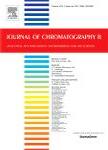版权所有:内蒙古大学图书馆 技术提供:维普资讯• 智图
内蒙古自治区呼和浩特市赛罕区大学西街235号 邮编: 010021

作者机构:Natl Inst Pharmaceut Educ & Res NIPER Hajipur Dept Pharmaceut Anal Hajipur 844102 Bihar India Natl Inst Pharmaceut Educ & Res NIPER Dept Pharmacol & Toxicol Hajipur 844102 Bihar India Louisiana State Univ Biol & Agr Engn Dept Baton Rouge LA USA
出 版 物:《JOURNAL OF CHROMATOGRAPHY B-ANALYTICAL TECHNOLOGIES IN THE BIOMEDICAL AND LIFE SCIENCES》 (J. Chromatogr. B Anal. Technol. Biomed. Life Sci.)
年 卷 期:2025年第1252卷
页 面:124474页
核心收录:
学科分类:0710[理学-生物学] 1001[医学-基础医学(可授医学、理学学位)] 0703[理学-化学] 10[医学]
基 金:Department of Pharmaceuticals Ministry of Chemicals and Fertilizers
主 题:AQbD Arsenic speciation Central composite design HEK-293
摘 要:An analytical quality by design-guided LC-ICP-MS method for simultaneous arsenic speciation analysis in HEK293 cells was optimized and validated. Initially, critical method variables (CMVs) were identified to achieve the targeted critical quality attribute (CQA) of the analytical target profile (ATP). Based on knowledge and risk assessments, formic acid (X1), citric acid (X2), and pH (X3) were studied for their effect on method responses such as resolutions (Y1, Y2) and retention time of As(V), As(III) and DMA (Y3, Y4, and Y5) using central composite design (CCD). ANOVA analysis indicated that variable interaction was significant in method responses with curvature effect on resolution (Y1 and Y2). The method operable design region (MODR) afforded a 0.1% formic acid, citric acid strength of 20-30 mM, and pH 5.6-6.8 as a robust region for the appropriate method performance. Hence, the final method was optimized on the ZORBAX RRHD SB-Aq column using a mobile phase consisting of 0.1% Formic acid: Citric acid (22.5 mM) (50:50 % v/v;pH 5.6). The optimized method eluted As (V), As(III), and DMA at 2.5 +/- 0.1, 2.7 +/- 0.1, and 3.1 +/- 0.1 min, respectively, with an acceptable resolution. The LOD of the method was 4.78, 3.39, 5.35 ppb respectively for As(V), As(III), and DMA whilst the linearity was established at 30-1000 ppb for all species with respective r2-value of 0.9967, 0.9996, and 0.9972, respectively. The % recovery (77.11-99.64 %) and precision (0.25-1.95 %) were acceptable. The method has proven robust for method variables. Notably, we conducted the Green-white analytical chemistry assessment for the developed method by three different assessment tools viz., AGREES, GAPI, and RGB of 12 algorithms. The developed method demonstrated robustness, environmental friendliness, and user-friendliness.